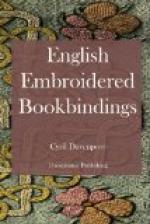those associated with the name of Samuel Mearne, the
King’s Binder, preserve this character, though
the attempt to break the formality of the rectangle
by the bulges at the side and the little penthouses
at foot and head (whence its name, the ‘cottage’
style) was not wholly successful. The use of
the labour-saving device of the ‘roll,’
in preference to impressing each section of the pattern
by hand, is another blot. Nevertheless, it is
almost impossible to find an English or Scotch binding
of this period which is less than charming, and the
best of them are admirable. At the beginning
of the eighteenth century a new grace was added by
the inlaying of a leather of a second colour.
These inlaid English bindings are few in number (the
British Museum has not a single fine example), but
those who know the specimens exhibited at the Burlington
Fine Arts Club, two of which are figured in its Catalogue,
will readily allow that their grace has never been
surpassed. The fine Harleian bindings let us
down gently from this eminence, and then, after a
period of mere dulness, with the rise of Roger Payne
we have again an English school (for Payne’s
traditions were worthily followed by Charles Lewis)
which, by common consent, was the finest of its time.
Payne’s originality is, perhaps, not quite so
absolute as has been maintained, for some of his tools
were cut in the pattern of Mearne’s, and it would
be possible to find suggestions for some of his schemes
of arrangement in earlier English work. If he
borrowed, however, he borrowed from his English predecessors,
and he brought to his task an individuality and an
artistic instinct which cannot be denied.
After Payne and Lewis, English binding, like French,
became purely imitative in its designs; but while
in our own decade the French artists have endeavoured
to shake themselves free from old traditions by mere
eccentricity, in England we have several living binders,
such as Mr. Cobden Sanderson and Mr. Douglas Cockerell,
who work with notable originality and yet with the
strictest observance of the canons of their art.
Moreover in the application of decorative designs
to cloth cases England has invented, and England and
America have brought to perfection, an inexpensive
and very pleasing form of book-cover, which gives the
bookman ample time to consider whether his purchase
is worth the more permanent honours of gilded leather,
and also, by the facts that it is avowedly temporary,
and that its decoration is cheaply and easily effected
by large stamps, renders forgivable vagaries of design,
which when translated, as they have been of late years
in France, into the time-honoured and solemn leather,
seem merely incongruous and irreverent.




